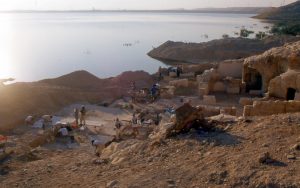First aid and assistance on the excavation
During all the excavation phases, the archaeologists were given technical indications to avoid damage to surfaces and objects. In particular, when mosaics and frescoes were discovered, they were asked to leave a 10 cm layer of earth on the surfaces to mitigate the effects of rapid exposure and avoid formation of insoluble surface layers.
Removal of the earth left during excavation and final cleaning of exposed parts were done very quickly with the help of many hands. This lowered the time of exposure to air and heat and avoided the formation of insoluble layers before surface deposits could be removed and soluble salts partially removed. The operation was done with soft plastic brushes, synthetic sponges, a 2% solution of a mild disinfectant in water and a water vacuum.
Thousands of objects, primarily bronze, iron, glass, some ivory, wood, and bone were recovered during the excavation. Most of these materials are damaged when they pass from the damp, stable conditions of burial to being exposed to a suddenly hot, dry environment and direct sunshine.
The damage can be multiplied by archaeological requirements for study, drawing, and photographic documentation of the finds, which find themselves exposed to the air for a long time.
For all finds, a first-aid program was implemented so as to minimize the damaging effects of exposure between the time they were discovered and when they arrived at the laboratory for conservation.
In general, one or more of the following operations were performed:
impeding exposure to direct sunlight by putting the objects into geotextile bags of various sizes. Bronze and iron objects were first packed in polyethylene bags with small holes to permit gradual passage to the external microclimate; then they were inserted in the geotextile.
In the case of large or very fragile objects, they were excavated in a block while still in contact with a section of earth. The methods and materials used varied according to the type of artifact, from a simple rigid sheet inserted beneath the earth layer to recovery with expanded polyurethane foam.
All the objects were taken to storage on a daily basis for analysis of the data and additional first conservation treatments.
For the inscriptions and graffiti found on exposed structures or objects that were too heavy or fragile to be handled, latex molds were taken in order to provide full documentation. Objects were first cleaned of all deposits on the surface and inside the incisions, and any fragile areas were consolidated. Once the mold was removed, a cast of the original could be produced that was virtually perfect. Each one was then scanned and added to the archaeological archive on a computer, and the archaeologists could study the inscriptions and graffiti on a light table without having to handle the originals.





















